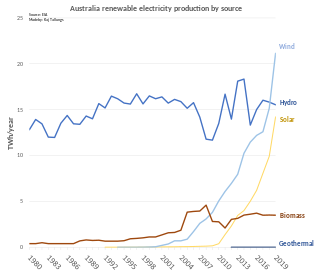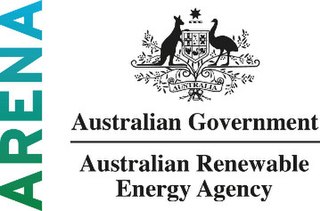
Solar energy is radiant light and heat from the Sun that is harnessed using a range of technologies such as solar power to generate electricity, solar thermal energy, and solar architecture. It is an essential source of renewable energy, and its technologies are broadly characterized as either passive solar or active solar depending on how they capture and distribute solar energy or convert it into solar power. Active solar techniques include the use of photovoltaic systems, concentrated solar power, and solar water heating to harness the energy. Passive solar techniques include orienting a building to the Sun, selecting materials with favorable thermal mass or light-dispersing properties, and designing spaces that naturally circulate air.
Ocean thermal energy conversion (OTEC) is a renewable energy technology that harnesses the temperature difference between the warm surface waters of the ocean and the cold depths to produce electricity. It is a unique form of clean energy generation that has the potential to provide a consistent and sustainable source of power. Although it has challenges to overcome, OTEC has the potential to provide a consistent and sustainable source of clean energy, particularly in tropical regions with access to deep ocean water.

A power station, also referred to as a power plant and sometimes generating station or generating plant, is an industrial facility for the generation of electric power. Power stations are generally connected to an electrical grid.

Pumped-storage hydroelectricity (PSH), or pumped hydroelectric energy storage (PHES), is a type of hydroelectric energy storage used by electric power systems for load balancing. The method stores energy in the form of gravitational potential energy of water, pumped from a lower elevation reservoir to a higher elevation. Low-cost surplus off-peak electric power is typically used to run the pumps. During periods of high electrical demand, the stored water is released through turbines to produce electric power. Although the losses of the pumping process make the plant a net consumer of energy overall, the system increases revenue by selling more electricity during periods of peak demand, when electricity prices are highest. If the upper lake collects significant rainfall or is fed by a river then the plant may be a net energy producer in the manner of a traditional hydroelectric plant.

Tidal power or tidal energy is harnessed by converting energy from tides into useful forms of power, mainly electricity using various methods.

Wave power is the capture of energy of wind waves to do useful work – for example, electricity generation, water desalination, or pumping water. A machine that exploits wave power is a wave energy converter (WEC).

The Pelamis Wave Energy Converter was a technology that used the motion of ocean surface waves to create electricity. The machine was made up of connected sections which flex and bend as waves pass; it is this motion which is used to generate electricity.

Renewable energy in Australia includes wind power, hydroelectricity, solar photovoltaics, heat pumps, geothermal, wave and solar thermal energy.
The Wave Hub is a floating offshore wind and wave power research project. The project is developed approximately 10 miles (16 km) off Hayle, on the north coast of Cornwall, United Kingdom. The hub was installed on the seabed in September 2010, and is a 'socket' sitting on the seabed for wave energy converters to be plugged into. It will have connections to it from arrays of up to four kinds of wave energy converter. A cable from the hub to main land will take electrical power from the devices to the electric grid. The total capacity of the hub will be 20 MWe. The estimated cost of the project is £28 million.
Oceanlinx was a company established in 1997 which specialised in the research and development of ocean-based renewable energy technology. The company's central technology was based on the Wave Energy Converter "WEC" which converts wave energy into electrical energy. Oceanlinx technology focused on the oscillating water column principle, and developed several prototype generators which were deployed and tested in Port Kembla, New South Wales. In 2014, Oceanlinx entered receivership and its technology, intellectual property, brand and trademark were sold to Wave Power Renewables Limited in Hong Kong. Wave Power Renewables Limited has continued to develop the technology, and Oceanlinx's founding director, Tom Denniss has further developed the technology since 2016 as a director of Wave Swell Energy.

Renewable energy in the United Kingdom contributes to production for electricity, heat, and transport.

CETO is a wave-energy technology that converts kinetic energy from ocean swell into electrical power and directly desalinates freshwater through reverse osmosis. The technology was developed and tested onshore and offshore in Fremantle, Western Australia. In early 2015 a CETO 5 production installation was commissioned and connected to the grid. As of January 2016 all the electricity generated is being purchased to contribute towards the power requirements of HMAS Stirling naval base at Garden Island, Western Australia. Some of the energy will also be used directly to desalinate water.

The European Marine Energy Centre (EMEC) Ltd is a UKAS accredited test and research center focused on wave and tidal power development, based in the Orkney Islands, UK. The centre provides developers with the opportunity to test full-scale grid-connected prototype devices in wave and tidal conditions.
The Oyster was a hydro-electric wave energy device that used the motion of ocean waves to generate electricity. It was made up of a Power Connector Frame (PCF), which is bolted to the seabed, and a Power Capture Unit (PCU). The PCU is a hinged buoyant flap that moves back and forth with movement of the waves. The movement of the flap drives two hydraulic pistons that feed high-pressured water to an onshore hydro-electric turbine, which drives a generator to make electricity. Oyster was stationed at the European Marine Energy Centre (EMEC) at its Billia Croo site in Orkney, Scotland until the company ceased trading in 2015.

Marine energy or marine power refers to the energy carried by ocean waves, tides, salinity, and ocean temperature differences. The movement of water in the world's oceans creates a vast store of kinetic energy, or energy in motion. Some of this energy can be harnessed to generate electricity to power homes, transport and industries.
Independent Natural Resources, Inc. or INRI is an American IP holding company based in Eden Prairie, Minnesota. It formed Renew Blue in Dallas as a wholly owned subsidiary charged with licensing the SEADOG pump.

Australia is the driest habitable continent on Earth and its installed desalination capacity has been increasing. Until a few decades ago, Australia met its demands for water by drawing freshwater from dams and water catchments. As a result of the water supply crisis during the severe 1997–2009 drought, state governments began building desalination plants that purify seawater using reverse osmosis technology. Approximately one percent of the world's drinkable water originates from desalination plants.

A tidal stream generator, often referred to as a tidal energy converter (TEC), is a machine that extracts energy from moving masses of water, in particular tides, although the term is often used in reference to machines designed to extract energy from run of river or tidal estuarine sites. Certain types of these machines function very much like underwater wind turbines, and are thus often referred to as tidal turbines. They were first conceived in the 1970s during the oil crisis.

The Australian Renewable Energy Agency (ARENA) is an independent agency of the Australian federal government, established in 2012 to manage Australia's renewable energy programs, with the objective of increasing supply and competitiveness of Australian renewable energy sources.















